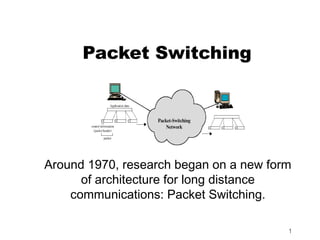
Packet switching
- 1. Packet Switching Around 1970, research began on a new form of architecture for long distance communications: Packet Switching. 1
- 2. Introduction Packet Switching refers to protocols in which messages are divided into packets before they are sent. Each packet is then transmitted individually and can even follow different routes to its destination. Once all the packets forming a message arrive at the destination, they are recompiled into the original message. 2
- 3. Packet Switching Operation Data are transmitted in short packets. Typically an upper bound on packet size is 1000 octets. If a station has a longer message to send it breaks it up into a series of small packets. Each packet now contains part of the user's data and some control information. The control information should at least contain: Destination Address Source Address Store and forward - Packets are received, stored briefly (buffered) and past on to the next node 3
- 4. Advantages Line efficiency Single node to node link can be shared by many packets over time Packets queued and transmitted as fast as possible Data rate conversion Each station connects to the local node at its own speed Nodes buffer data if required to equalize rates Packets are accepted even when network is busy Delivery may slow down Priorities can be used 4
- 5. Switching Technique - Virtual Circuits and Datagrams Station breaks long message into packets Packets sent one at a time to the network Packets handled in two ways Datagram Virtual circuit 5
- 6. Datagram Packet Switching In datagram approach each packet is treated independently with no reference to packets that have gone before. No connection is set up. Packets can take any practical route Packets may arrive out of order Packets may go missing Up to receiver to re-order packets and recover from missing packets More processing time per packet per node Robust in the face of link or node failures. 6
- 8. Virtual Circuit Packet Switching In the Virtual Circuit approach a pre-planned route is established before any packets are sent. There is a call set up before the exchange of data (handshake). All packets follow the same route and therefore arrive in sequence. Each packet contains a virtual circuit identifier instead of destination address More set up time No routing decisions required for each packet - Less routing or processing time Susceptible to data loss in the face of link or node failure Clear request to drop circuit Not a dedicated path 8
- 10. Virtual Circuits vs. Datagram Virtual circuits Network can provide sequencing and error control Packets are forwarded more quickly No routing decisions to make Less reliable Loss of a node looses all circuits through that node Datagram No call setup phase Better if few packets More flexible Routing can be used to avoid congested parts of the network 10
- 11. Packet switching - datagrams or virtual circuits Interface between station and network node Connection oriented Station requests logical connection (virtual circuit) All packets identified as belonging to that connection & sequentially numbered Network delivers packets in sequence External virtual circuit service e.g. X.25 Different from internal virtual circuit operation Connectionless Packets handled independently External datagram service Different from internal datagram operation 11
- 14. Circuit vs. Packet Switching Performance Propagation delay Transmission time Node delay 14
- 15. Comparison with Circuit Switching - Event Timing 15
- 17. Packet Switching Evolution X.25 packet-switched network Router-based networking Switching vs. routing Frame relay network ATM network 17
- 18. Switching vs Routing Switching Routing path set up at connection can work as connectionless time complex routing algorithm simple table look up table maintainance via table maintainance via protocol signaling out of sequence delivery no out of sequence delivery likely lost path may lose robust: no connections lost connection significant processing delay much faster than pure output link decision based on routing packet header contents - at link decision made ahead of every node time, and resources allocated then 18